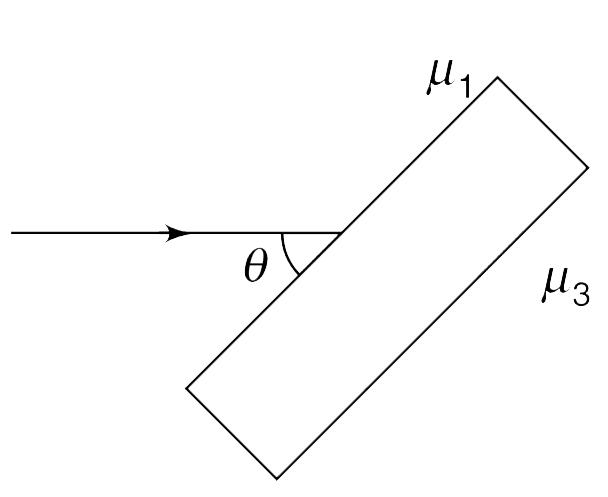Why does a parallel faced glass slab neither produce dispersion nor deviation?
A rectangular glass slab is equivalent to two similar prisms placed with their bases inverted. The deviation and dispersion produced by two prisms are equal but in opposite directions. So, both the net deviation and dispersion are zero.
Topper's Solved these Questions
Similar Questions
The refractive indices of crown glass for blue and red light are 1.523 and 1.513, respectively and of dense flint glass, 1.773 and 1.743, respectively. Calculate the dispersive power of the material. What must be the anlgle of a flint glass prism which may be combined with a crown glass prism of angle 5∘ so that the combination produces dispersion without deviation? What dispersion does the combination produces?
View SolutionTwo thin prisms are combined such that they neither produce any average deviation nor do they cause any dispersion when white light is incident on the combination. Angle of one prism is A=2° and refractive index of its glass for red, yellow and violet lights are 1.49, 1.50 and 1.51 respectively. Find the dispersive power of the glass of the other prism.
View Solution
Knowledge Check
Statement-1 : Two prism joined in opposite alone can produce dispersion without deviation or deviation without dispersion.
Statement-2 : Dispersion is due to different deviation only.AStatement-1 is true, Statement-2 is true.
Statement-2 is correct explanation of Statement-1.BStatement-1 is true, Statement-2 is true, but Statement-2 is not a correct explanation of Statement-1.CStatement-1 is true, Statement-2 is false.DStatement-1 is fasle, Statement-2 is true.Ordinary light incident on a glass slab at the polarising angle suffers a deviation of 34∘ . The velue of the angle of refraction in glass in this case is
A28∘B42∘C56∘D68∘
A light ray travelling in a medium of refractive index μ1 is incident on a parallel faced glass slab making an angle of θ with the glass surface. The refractive index of the medium on the other side of the glass slab is μ3(>μ1). Find the angular deviation suffered by the light ray.

View SolutionAssertion: if a glass slab is placed in front of one of the slits, then fringe with will decreases.
Reason: Glass slab with produce an additional path difference.
View SolutionAssertion: if a glass slab is placed in front of one of the slits, then fringe with will decreases.
Reason: Glass slab with produce an additional path difference.
View SolutionCalculate the dispersion and deviation ( mean) produced by a flint glass prism placed in the position of minimum deviation with respect to the mean colour. The angle of prism is 60∘. Also calculate the dispersive power of the prism. Index of refraction of flint glass for blue light=0.667 and that for the red light =1.643.
View SolutionWhy does a light ray incident on a rectangular glass slab immersed in any medium emerges parallel to itself ? Explain using a diagram.
View SolutionWhy does a light ray incident on a rectangular glass slab immersed in any medium emerges parallel to itself ? Explain using a diagram.
View Solution
